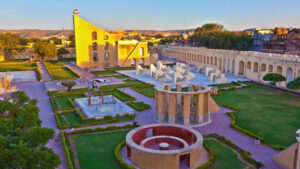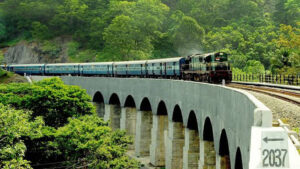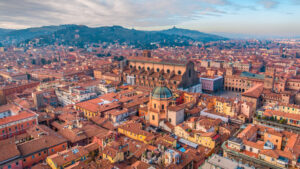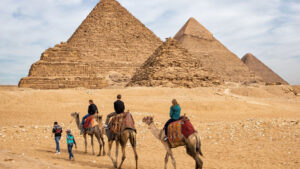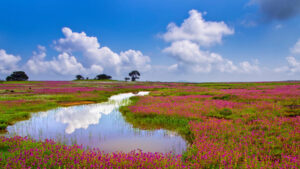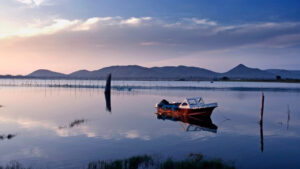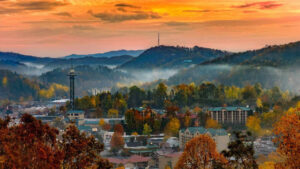BUNDI STEPWELLS, RAJASTHAN – EXPLORE THE ENCHANTING ARCHITECTURAL SPLENDOR

Bundi, a small city located in the state of Rajasthan, India, is renowned for its magnificent stepwells. Nestled in the heart of Rajasthan, India, Bundi Stepwells stand as remarkable landmarks that beckon travelers with their awe-inspiring beauty and historical significance. These architectural marvels, known as baoris or bawdis, have long been an integral part of the region’s heritage, serving as essential sources of water and community gathering places. Bundi Stepwells, with their intricate carvings, multi-tiered structures, and cultural importance, invite visitors to immerse themselves in the enchanting world of ancient water management systems. As you traverse the steps that lead deep into the earth, you will be captivated by the mesmerizing craftsmanship and the stories whispered by the walls. A visit to Bundi is incomplete without experiencing the grandeur and charm of these stepwells, making it a must-visit destination for those seeking to uncover the rich cultural tapestry of Rajasthan.

Stepwells, also known as baoris or bawdis, are architectural marvels that have been an integral part of Indian culture for centuries. Here are some interesting facts about the stepwells in Bundi:
- Architectural Masterpieces: Bundi Stepwells are renowned for their architectural brilliance. They showcase intricate carvings, ornate pavilions, and beautiful sculptures that reflect the craftsmanship of the artisans of that era. The detailing on the walls and pillars of the stepwells is a testament to the artistic skills prevalent during the medieval period.
- Ancient Water Management: Stepwells played a crucial role in water conservation and management in arid regions like Rajasthan. They were designed to store rainwater during the monsoon season and provide a sustainable source of water throughout the year. The step-like structure allowed easy access to the water at different levels, even during times of low water availability.
- Cultural Significance: Stepwells held cultural and religious significance in Indian society. They were not only practical structures for water storage but also served as community gathering places. People would gather around the stepwells for socializing, washing clothes, and seeking respite from the scorching desert heat. Many stepwells were adorned with religious sculptures and idols, reflecting the spiritual and cultural diversity of the region.
- Architectural Influence: The stepwells of Bundi have had a significant influence on subsequent architectural styles. Their unique design elements, such as intricate carvings, symmetrical patterns, and grand entrances, have inspired later structures, including palaces and temples in Rajasthan.
- Preservation Efforts: Over the years, efforts have been made to preserve and restore the stepwells of Bundi. Restoration projects aim to maintain the structural integrity and intricate artwork of these historical treasures, ensuring that they can be appreciated by future generations.
- UNESCO World Heritage Recognition: Although Bundi Stepwells are not individually listed as UNESCO World Heritage Sites, they are part of the larger “Hill Forts of Rajasthan” UNESCO World Heritage Site designation. The inclusion acknowledges the historical and cultural significance of the stepwells as integral components of the region’s architectural heritage.
- Popular Stepwells in Bundi: Some of the popular stepwells in Bundi that attract visitors include Raniji ki Baori, Nawal Sagar, and Dabhai Kund. Each stepwell has its own unique features, architectural elements, and historical stories to discover.
Exploring the stepwells of Bundi offers not only a glimpse into the rich history and architectural splendor of the region but also a deeper understanding of the water management systems and cultural practices of the past.
Activities Enjoyed by Tourists
Tourists visiting Bundi and its mesmerizing stepwells can enjoy a range of activities that cater to various interests. Here are some popular activities enjoyed by tourists in Bundi:

- Stepwell Exploration: The primary activity in Bundi revolves around exploring the stepwells. Visitors can descend the steps and wander through the multi-tiered structures, marveling at the intricate carvings, sculptures, and architectural details. Exploring different stepwells, such as Raniji ki Baori, Nawal Sagar, and Dabhai Kund, allows you to appreciate the unique features and historical significance of each.
- Photography: Bundi’s stepwells offer fantastic opportunities for photography enthusiasts. The ornate architecture, play of light and shadows, and intricate carvings provide a visually captivating setting for capturing stunning images. Whether you’re a professional photographer or an amateur with a smartphone, you’ll find plenty of inspiring subjects to photograph.
- Cultural Immersion: Engaging in cultural activities allows visitors to connect with the local community and gain insights into the traditions and way of life in Bundi. Interacting with artisans, observing their craftsmanship, and participating in workshops on traditional arts and crafts offer a deeper understanding of the region’s cultural heritage.
- Exploring Historical Sites: In addition to the stepwells, Bundi is home to numerous historical sites that are worth exploring. Visitors can discover the grandeur of Bundi Palace, which offers panoramic views of the city and houses splendid murals depicting Rajput tales. The Taragarh Fort, perched on a hilltop, provides a glimpse into the city’s military past and offers breathtaking vistas of the surrounding landscape.
- Visiting Temples: Bundi boasts several beautifully adorned temples that are sacred to the locals. Visitors can explore temples like Rani Ji Ki Baori Temple, Chitrashala Temple, and Badal Mahal Temple, and admire their architectural beauty and religious significance. It’s important to respect the sanctity of these places and adhere to the local customs and traditions while visiting.
- Food and Shopping: Indulging in the local cuisine and shopping for traditional handicrafts are experiences not to be missed in Bundi. Visitors can savor authentic Rajasthani delicacies like dal bati churma, gatte ki sabzi, and kachori. The bustling markets offer a variety of items, including miniature paintings, textiles, silver jewelry, and colorful turbans, allowing visitors to take a piece of Bundi’s vibrant culture back home.
- Cultural Events and Festivals: Depending on the time of visit, tourists may have the opportunity to witness or participate in cultural events and festivals. Bundi is known for its vibrant Teej Festival, which celebrates the advent of the monsoon season with colorful processions, folk performances, and traditional rituals. This festival offers a unique chance to witness the local traditions and festivities.
Other Attractions Nearby
In addition to the captivating stepwells and historical sites within Bundi itself, there are several attractions nearby that are worth exploring. Here are some notable attractions in and around Bundi:

- Jait Sagar Lake: Located just a short distance from Bundi, Jait Sagar Lake is a serene and picturesque water body surrounded by lush greenery. The tranquil ambiance and scenic beauty of the lake make it an ideal spot for a peaceful stroll or a picnic with breathtaking views.
- Bhimlat Waterfall: Situated approximately 25 kilometers from Bundi, Bhimlat Waterfall is a natural marvel nestled amidst the scenic Aravalli hills. The waterfall cascades down from a height of about 60 meters, creating a mesmerizing sight. It’s a popular spot for nature lovers and adventure enthusiasts, offering opportunities for hiking and photography.
- Rameshwaram Mahadev Temple: Located on the banks of the Chambal River, about 10 kilometers from Bundi, Rameshwaram Mahadev Temple is a significant pilgrimage site. Dedicated to Lord Shiva, the temple is known for its architectural beauty and religious importance. The peaceful surroundings and serene atmosphere make it a place for spiritual contemplation.
- Keshavraipatan: Situated around 35 kilometers from Bundi, Keshavraipatan is a town known for its historical and religious significance. It is home to the ancient Keshavrai Vishnu Temple, which features exquisite sculptures and intricate carvings. The town also has a stepwell called Chand Baori, which is worth exploring.
- Menal: Located approximately 45 kilometers from Bundi, Menal is a scenic village known for its beautiful waterfalls, ancient temples, and natural surroundings. The Menal Waterfall, surrounded by lush green forests, creates a mesmerizing sight. The village is also home to ancient temples dedicated to Lord Shiva, showcasing architectural splendor.
- Ramgarh Vishdhari Wildlife Sanctuary: Situated around 50 kilometers from Bundi, Ramgarh Vishdhari Wildlife Sanctuary is a haven for nature and wildlife enthusiasts. Spanning across a vast area, the sanctuary is home to a variety of flora and fauna, including leopards, deer, monkeys, and numerous bird species. Exploring the sanctuary offers opportunities for wildlife spotting and nature walks.
How to Reach
Bundi is well-connected to major cities in Rajasthan and other parts of India, making it relatively easy to reach. Here are the common modes of transportation to reach Bundi:
By Air: The nearest airport to Bundi is Jaipur International Airport, which is located approximately 210 kilometers away. From Jaipur, you can hire a taxi or take a bus to Bundi. Jaipur Airport has regular domestic and international flights, making it convenient for both domestic and international travelers.
By Train: Bundi has its own railway station, which is well-connected to major cities in India. Several trains run to and from Bundi, connecting it to destinations like Delhi, Jaipur, Mumbai, and Kolkata. From the railway station, you can hire a taxi or an auto-rickshaw to reach your desired location within Bundi.
By Road: Bundi is well-connected by road, and you can reach the city via private or public transport. The National Highway 52 passes through Bundi, linking it to various cities in Rajasthan and neighboring states. You can opt to drive to Bundi from nearby cities or take a bus operated by the Rajasthan State Road Transport Corporation (RSRTC) or private bus services.

Best Time to Visit
The best time to visit Bundi is during the winter months, from October to February, when the weather is pleasant and suitable for exploring the city’s attractions. The temperatures during this time range from around 8°C to 25°C (46°F to 77°F), making it ideal for outdoor activities and sightseeing. The winter season offers relief from the scorching heat of the summer months, allowing visitors to explore Bundi’s stepwells, palaces, and temples comfortably. Moreover, the festive season in Rajasthan during October and November adds an extra charm to the visit, with colorful celebrations and cultural events. It’s important to note that during the winter months, especially in December and January, the nights can get quite cold, so carrying some warm clothing is advisable. Overall, visiting Bundi during the winter season ensures a pleasant and enjoyable experience amidst the city’s historical and architectural wonders.





